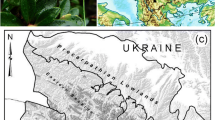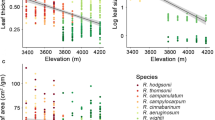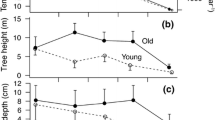Abstract
In order to examine the role of environmental factors affecting foliar morphology, we performed a case study of leaf morphological variation of Ranunculus natans found in the arid zone of northwest China. We found that foliar phenotypic variation differed significantly between populations. We described substantial positive correlations between altitude and leaf area (LA) as well as leaf perimeter (LP), and also between longitude and number of teeth, along with dissection index (DI). The pH, conductivity, and salinity of the environment caused a significant decrease in both LA and LP. Ranked in terms of their impacts on leaf morphology, the six selected factors were: altitude > pH > conductivity > salinity > longitude > latitude. We found that foliar morphological variations are functional responses to water-quantity factors (e.g., altitude and longitude at regional scales) and water-availability relation factors (e.g., pH, conductivity, and salinity at local scales), rather than to temperature-relation factors (latitude). Therefore, altitude and longitude, along with pH, conductivity, and salinity, are the main factors that significantly influence foliar morphology in the arid zone of China. We found that main factors played major roles in plant phenotypic plasticity in a complex ecosystem, although different combinations and interactions of environmental and geographical factors in each local environment may obscure the general trends in trait changes along environmental gradients.








Similar content being viewed by others
References
Anonymous (1985) Nature geography of China (Pandect). Science Press, Beijing
Barrett SCH, Eckett CG, Husband BC (1993) Evolutionary processes in aquatic plant population. Aquat Bot 44:105–145. doi:10.1016/0304-3770(93)90068-8
Chabot B, Chabot J (1977) Effects of light and temperature on leaf anatomy and photosynthesis in Fragaria vesca. Oecologia 26:363–377. doi:10.1007/BF00345535
Chapin FS, Chapin MC (1981) Ecotypic differentiation of growth processes in Carex aquatilis along latitudinal and local gradients. Ecology 62:1000–1009. doi:10.2307/1936999
Cook CDK (1968) Phenotypic plasticity with particular reference to three amphibious plant species. In: Heywood V (ed) Modern methods in plant taxonomy. Academic Press, London, pp 97–111
Cook SA, Johnson MP (1968) Adaptation to heterogeneous environments. I. Variation in heterophylly in Ranunculus flammula L. Evol Int J Org Evol 22:495–516. doi:10.2307/2406876
Cunningham SA, Summerhayes B, Westoby M (1999) Evolutionary divergences in leaf structure and chemistry, comparing rainfall and soil nutrient gradients. Ecol Monogr 69:69–588
Deschamp PA, Cooke TJ (1985) Leaf dimorphism in the aquatic angiosperm Callitriche heterophylla. Am J Bot 72:1377–1387. doi:10.2307/2443509
Emery RJN, Chinnappa CC, Chmielewski JG (1994) Specialization, plant strategies, and phenotypic plasticity in populations of Stellaria longipes along an elevation gradient. Int J Plant Sci 155:9–23. doi:10.1086/297160
Fahn A, Cutler DF (1992) Xerophytes. Gegrüder Borntraeger, Berlin
Feng SZ, Xu DF, Lei XY (1989) Nature geography of China. High Education Press, Beijing
Fonseca CR, Overton JC, Collins B, Westoby M (2000) Shifts in trait-combinations along rainfall and phosphorus gradients. J Ecol 88:964–977. doi:10.1046/j.1365-2745.2000.00506.x
Fowler NL, Antonovics J (1981) Small-scale variability in the demography of transplants of two herbaceous species. Ecology 62:1450–1457 doi:10.2307/1941501
Givnish TJ (1987) Comparative studies of leaf form: assessing the relative roles of selective pressures and phylogenetic constraints. New Phytol 106:131–160
González-Rodríguez A, Oyama K (2005) Leaf morphometric variation in Quercus affinis and Q. laurina (Fagaceae), two hybridizing Mexican red oaks. Bot J Linn Soc 147:427–435. doi:10.1111/j.1095-8339.2004.00394.x
Greulich S, Barrat-segretain MH, Bornette G (2001) Basal rosette or floating leaf canopy–an example of plasticity in a rare aquatic macrophyte. Hydrobiologia 448:53–59. doi:10.1023/A:1017530102260
Hegazy AK, El Amry MI (1998) Leaf temperature of desert sand dune plants: perspectives on the adaptability of leaf morphology. Afr J Ecol 36:34–43. doi:10.1046/j.1365-2028.1998.109-89109.x
Hoeinghaus DJ, Winemiller KO, Birnbaum JS (2007) Local and regional determinants of stream fish assemblage structure: inferences based on taxonomic vs. functional groups. J Biogeogr 34:324–328. doi:10.1111/j.1365-2699.2006.01587.x
Hovenden MJ, Vander Schoor JK (2003) Nature vs nurture in the leaf morphology of Southern beech, Nothofagus cuninghamii(Nothofagaceae). New Phytol 161:585–594. doi:10.1046/j.1469-8137.2003.00931.x
Junghans U, Polle A, Düchting P, Weiler E, Kuhlman B, Gruber F, Teichmann T (2006) Adaptation to high salinity in poplar involves changes in xylem anatomy and auxin physiology. Plant Cell Environ 29:1519–1531. doi:10.1111/j.1365-3040.2006.01529.x
Kincaid DT, Schneider RB (1983) Quantification of leaf shape with a microcomputer and Fourier transform. Can J Bot 61:2333–2342. doi:10.1139/b83-256
Knight CA, Ackerly DD (2003) Evolution and plasticity of photosynthetic thermal tolerance, specific leaf area and leaf size: congeneric species from desert and coastal environments. New Phytol 160:337–347. doi:10.1046/j.1469-8137.2003.00880.x
Koch EW, Dawes CJ (1991) Ecotypic differentiation in populations of Ruppia maritima L. germinated from seeds and cultured under algae-free laboratory conditions. J Exp Mar Biol Ecol 152:145–159. doi:10.1016/0022-0981(91)90212-F
Körner C, Bannister P, Mark AF (1986) Altitudinal variation in stomatal conductance, nitrogen content and leaf anatomy in different plant life forms in New Zealand. Oecologia 69:577–588. doi:10.1007/BF00410366
Lynn DE, Waldren S (2001) Morphological variation in population of Ranunculus repens from the temporary limestone lakes (Turloughs) in the west of Ireland. Ann Bot (Lond) 87:9–17. doi:10.1006/anbo.2000.1293
Macdonald SE, Chinnappa CC (1989) Population differentiation for phenotypic plasticity in the Stellaria longipes complex. Am J Bot 76:1627–1637. doi:10.2307/2444400
Nardini A, Salleo S, Lo Gullo MA, Pitt F (2000) Different response to drought and freeze stress of Quercus ilex L. growing along a latitudinal gradient. Plant Ecol 148:139–147. doi:10.1023/A:1009840203569
Novoplansky A (1996) Developmental responses of individual Onobrychis plants to spatial heterogeneity. Vegetation 127:31–39. doi:10.1007/BF00054845
Santamaría L (2002) Why are most aquatic plants widely distributed? Dispersal, clonal growth and small-heterogeneity in a stressful environment. Acta Oecol 23:137–154. doi:10.1016/S1146-609X(02)01146-3
Santamaría L, Figuerola J, Pilon JJ, Mjelde M, Green AJ, De-Boer T, King RA, Gornall RJ (2003) Plant performance across latitude: the role of plasticity and local adaptation in aquatic plant. Ecology 84:2454–2461. doi:10.1890/02-0431
Schlichting CD (1986) The evolution of phenotypic plasticity in plants. Annu Rev Ecol Syst 17:667–693. doi:10.1146/annurev.es.17.110186.003315
Schlichting CD, Pigliucci M (1998) Phenotypic evolution: a reaction norm perspective. Sinauer Associates, Sunderland
Sokal RR, Rohlf FJ (1995) Biometry, 3rd edn. Freeman, New York
Sultan SE (1987) Evolutionary implications of phenotypic plasticity in plants. Evol Biol 21:127–168
Tang QC, Qu YG, Zhou ZC (1992) Hydrology and water resource utilization of arid region in China (In Chinese). Science Press, Beijing
Vestergaard O, Sand-Jensen K (2000) Alkalinity and trophic state regulate aquatic plant distribution in Danish lakes. Aquat Bot 67:85–107. doi:10.1016/S0304-3770(00)00086-3
Volis S, Mendlinger S, Ward D (2002) Differentiation in populations of Hordeum spontaneum along a gradient of environmental productivity and predictability: life history and local adaptation. Biol J Linn Soc 77:479–490. doi:10.1046/j.1095-8312.2002.00120.x
Winn AA (1999) Is seasonal variation in leaf traits adaptive for annual plant Dicerandra linearifolia?. J Evol Biol 12:306–313. doi:10.1046/j.1420-9101.1999.00031.x
Winn AA, Evans AS (1991) Variation among populations of Prunella vulgaris L. in plastic responses to light. Funct Ecol 5:899–902. doi:10.2307/2389639
Wright IJ, Reich PB, Westoby M (2001) Strategy shifts in leaf physiology, structure and nutrient content between species of high and low rainfall and high and low nutrient habitats. Funct Ecol 15:423–434. doi:10.1046/j.0269-8463.2001.00542.x
Acknowledgments
The authors gratefully acknowledge anonymous reviewers for their constructive comments on the manuscript, and we also thank Dr. Wen Xiong and Lingfei Yu for field collecting. The National Natural Science Foundation of China (30740067) and (30870260), the Postdoctoral Science Foundation of China (20070420180), the Natural Science Foundation of Hubei Province (2007ABA147) and the key project of Hubei Provincial Department of Education (D20081006) supported this research.
Author information
Authors and Affiliations
Corresponding author
About this article
Cite this article
Li, Z., Yu, D. Factors affecting leaf morphology: a case study of Ranunculus natans C. A. Mey. (Ranunculaceae) in the arid zone of northwest China. Ecol Res 24, 1323–1333 (2009). https://doi.org/10.1007/s11284-009-0617-2
Received:
Accepted:
Published:
Issue Date:
DOI: https://doi.org/10.1007/s11284-009-0617-2




